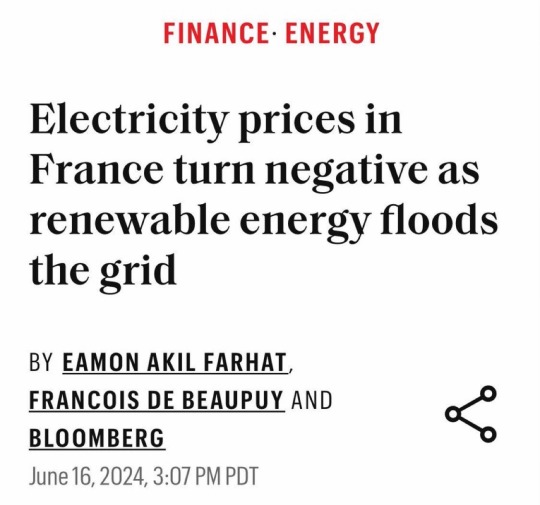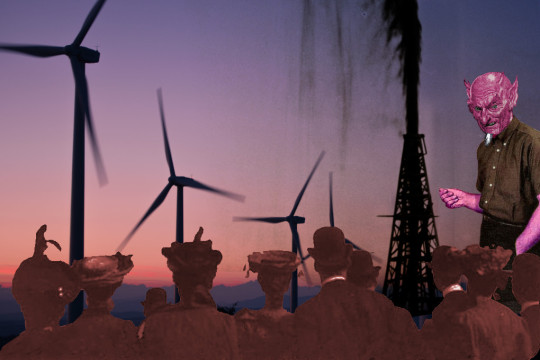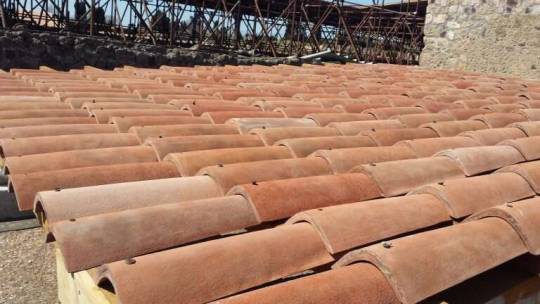#Renew Energy
Explore tagged Tumblr posts
Text
No matter what life throws at me, I always find a way to bounce back with my unwavering energy. It's the incredible power of healing that resides within me, allowing me to rise above any challenges and setbacks that come my way. With every setback, I embrace the opportunity to heal, grow, and emerge stronger than before. The feeling of restoration and well-being fills me with a sense of profound positivity and contentment. This ability to heal and rejuvenate is a constant reminder of the incredible strength we possess as human beings. It fuels my determination to live a fulfilling and vibrant life, embracing the power of healing with open arms.
.
#sunday 28th may#12:10 am#resilience#power of healing#renew energy#personal growth#thank you universe
54 notes
·
View notes
Text

Source

Source
#environment#France#solar energy#solar#green energy#the left#capitalism#politics#us politics#government#progressive#twitter post#current events#news#green new deal#climate change#renewable energy
3K notes
·
View notes
Text
"It is 70 years since AT&T’s Bell Labs unveiled a new technology for turning sunlight into power. The phone company hoped it could replace the batteries that run equipment in out-of-the-way places. It also realised that powering devices with light alone showed how science could make the future seem wonderful; hence a press event at which sunshine kept a toy Ferris wheel spinning round and round.
Today solar power is long past the toy phase. Panels now occupy an area around half that of Wales, and this year they will provide the world with about 6% of its electricity—which is almost three times as much electrical energy as America consumed back in 1954. Yet this historic growth is only the second-most-remarkable thing about the rise of solar power. The most remarkable is that it is nowhere near over.
To call solar power’s rise exponential is not hyperbole, but a statement of fact. Installed solar capacity doubles roughly every three years, and so grows ten-fold each decade. Such sustained growth is seldom seen in anything that matters. That makes it hard for people to get their heads round what is going on. When it was a tenth of its current size ten years ago, solar power was still seen as marginal even by experts who knew how fast it had grown. The next ten-fold increase will be equivalent to multiplying the world’s entire fleet of nuclear reactors by eight in less than the time it typically takes to build just a single one of them.
Solar cells will in all likelihood be the single biggest source of electrical power on the planet by the mid 2030s. By the 2040s they may be the largest source not just of electricity but of all energy. On current trends, the all-in cost of the electricity they produce promises to be less than half as expensive as the cheapest available today. This will not stop climate change, but could slow it a lot faster. Much of the world—including Africa, where 600m people still cannot light their homes—will begin to feel energy-rich. That feeling will be a new and transformational one for humankind.
To grasp that this is not some environmentalist fever dream, consider solar economics. As the cumulative production of a manufactured good increases, costs go down. As costs go down, demand goes up. As demand goes up, production increases—and costs go down further. This cannot go on for ever; production, demand or both always become constrained. In earlier energy transitions—from wood to coal, coal to oil or oil to gas—the efficiency of extraction grew, but it was eventually offset by the cost of finding ever more fuel.
As our essay this week explains, solar power faces no such constraint. The resources needed to produce solar cells and plant them on solar farms are silicon-rich sand, sunny places and human ingenuity, all three of which are abundant. Making cells also takes energy, but solar power is fast making that abundant, too. As for demand, it is both huge and elastic—if you make electricity cheaper, people will find uses for it. The result is that, in contrast to earlier energy sources, solar power has routinely become cheaper and will continue to do so.
Other constraints do exist. Given people’s proclivity for living outside daylight hours, solar power needs to be complemented with storage and supplemented by other technologies. Heavy industry and aviation and freight have been hard to electrify. Fortunately, these problems may be solved as batteries and fuels created by electrolysis gradually become cheaper...
The aim should be for the virtuous circle of solar-power production to turn as fast as possible. That is because it offers the prize of cheaper energy. The benefits start with a boost to productivity. Anything that people use energy for today will cost less—and that includes pretty much everything. Then come the things cheap energy will make possible. People who could never afford to will start lighting their houses or driving a car. Cheap energy can purify water, and even desalinate it. It can drive the hungry machinery of artificial intelligence. It can make billions of homes and offices more bearable in summers that will, for decades to come, be getting hotter.
But it is the things that nobody has yet thought of that will be most consequential. In its radical abundance, cheaper energy will free the imagination, setting tiny Ferris wheels of the mind spinning with excitement and new possibilities.
This week marks the summer solstice in the northern hemisphere. The Sun rising to its highest point in the sky will in decades to come shine down on a world where nobody need go without the blessings of electricity and where the access to energy invigorates all those it touches."
-via The Economist, June 20, 2024
#solar#solar power#solarpunk#hopepunk#humanity#electricity#clean energy#solar age#renewables#green energy#solar energy#renewable energy#solar panels#fossil fuels#good news#hope#climate change#climate hope
1K notes
·
View notes
Text
oh my god some of my work involves energy efficiency (i.e., finding ways to use less energy to do the same stuff) and electrification (i.e., taking appliances that run on fossil fuels like gas heaters and switching them out for electric ones that can run on solar power etc when available), and it is so maddening to me how often the conversation ends with "we just need to educate consumers, the public really needs education"
no! incorrect!! education lets you off the hook and makes it laypeople's responsibility to research and hold all this confusing-ass conflicting information on top of all their other shit! that is not realistic!!! the public needs you to make this SO EASY THEY CANNOT FUCK IT UP
people are busy! I do this professionally and it is a fuckign nightmare labyrinth quagmire trying to get rebates and whatnot for my own fucking house! MAKE IT EASIER, PEOPLE ARE BUSY AND HAVE THEIR OWN CONCERNS, MAKE IT FUCKING EASY
GOD
3K notes
·
View notes
Text
An end to the climate emergency is in our grasp

On June 20, I'm keynoting the LOCUS AWARDS in OAKLAND.

The problem with good news in the real world is that it's messy. Neat happy endings are for novels, not the real world, and that goes double for the climate emergency. But even though good climate news is complicated and nuanced, that doesn't mean it shouldn't buoy our spirits and fill our hearts with hope.
The big climate news this past week is the National Oceanic and Atmospheric Administration's clarion call about surging CO2 levels – the highest ever – amid a year that is on track to have the largest and most extreme series of weather events in human history:
https://www.noaa.gov/news-release/during-year-of-extremes-carbon-dioxide-levels-surge-faster-than-ever
This is genuinely alarming and you – like me – have probably experienced it as a kind of increase in your background radiation of climate anxiety. Perhaps you – like me – even experienced some acute, sit-bolt-upright-in-bed-at-2AM anxiety as a result. That's totally justifiable. This is very real, very bad news.
And yet…
The news isn't all bad, and even this terrible dispatch from the NOAA is best understood in context, which Bill McKibben provides in his latest newsletter post, "What You Want is an S Curve":
https://billmckibben.substack.com/p/what-you-want-is-an-s-curve
Financier and their critics should all be familiar with Stein's Law: "anything that can't go on forever will eventually stop." This is true outside of finance as well. One of the reasons that we're seeing such autophagic panic from the tech companies is that their period of explosive growth is at an end.
For years, they told themselves that they were experiencing double-digit annual growth because they were "creating value" and "innovating" but the majority of their growth was just a side-effect of the growth of the internet itself. When hundreds of millions of people get online every year, the dominant online services will, on average, gain hundreds of millions of new users.
But when you run out of people who don't have internet access, your growth is going to slow. How can it not? Indeed, at that point, the only ways to grow are to either poach users from your rivals (through the very expensive tactics of massive advertising and sales-support investments, on top of discounts and freebies as switching enticements), or to squeeze your own users for more.
That's why the number of laptops sold in America slowed down. It's why the number of cellphones sold in America slowed down. It's why the number of "smart home" gizmos slowed down.
Even the steepest hockey-stick-shaped exponential growth curve eventually levels off and becomes an S-curve, because anything that can't go on forever will eventually stop.
One way or another, the world's carbon emissions will eventually level off. Even if we drive ourselves to (or over) the brink of extinction and set up the conditions for wildfires that release all the carbon stored in all the Earth's plants, the amount of carbon we pump into the atmosphere has to level off.
Rendering the Earth incapable of sustaining human civilization (or life) is the ultimate carbon reduction method – but it's not my first choice.
That's where McKibben's latest newsletter comes in. He cites a new report from the Rocky Mountain Institute, which shows a major reversal in our energy sources, a shift that will see our energy primarily provided by renewables, with minimal dependence on fossil fuels:
https://rmi.org/insight/the-cleantech-revolution/
The RMI team says that in this year or next, we'll have hit peak demand for fossil fuels (a fact that is consistent with NOAA's finding that we're emitting more CO2 than ever). The reason for this is that so much renewable energy is about to come online, and it is so goddamned cheap, that we are about to undergo a huge shift in our energy consumption patterns.
This past decade saw a 12-fold increase in solar capacity, a 180-fold increase in battery storage, and a 100-fold increase in EV sales. China is leading the world in a cleantech transition, with the EU in close second. Cleantech is surging in places where energy demand is also still growing, like India and Vietnam. Fossil fuel use has already peaked in Thailand, South Africa and every country in Latin America.
We're on the verge of solar constituting an absolute majority of all the world's energy generation. This year, batteries will overtake pumped hydro for energy storage. Every cleantech metric is growing the way that fossil fuels did in previous centuries: investment, patents, energy density, wind turbine rotor size. The price of solar is on track to halve (again) in the next decade.
In short, cleantech growth looks like the growth of other technologies that were once rarities and then became ubiquitous overnight: TV, cellphones, etc. That growth isn't merely being driven by the urgency of the climate emergency: it's primarily a factor of how fucking great cleantech is:
https://rmi.org/wp-content/uploads/2024/05/the_incredible_inefficiency_of_fossils.pdf
Fossil fuels suck. It's not just that they wreck the planet, or that their extraction is both politically and environmentally disastrous. They just aren't a good way to make energy. About a third of fossil fuel energy is wasted in production and transportation. A third! Another third is wasted turning fossil fuels into energy. Two thirds! The net energy efficiency of fossil fuels is about 37%.
Compare that with cleantech. EVs convert electricity to movement with 80-90% efficiency. Heat pumps are 300% efficient (the main fuel for your heat pump is the heat in the atmosphere, not the electricity it draws).
Cleantech is just getting started – it's still in the hockey-stick phase. That means those efficiency numbers are only going up. Rivian just figured out how to remove 1.6 miles of copper wire from each vehicle. That's just one rev – there's doubtless lots of room for more redesigns that will further dematerialize EVs:
https://insideevs.com/news/722265/rivian-r1s-r1t-wiring/
As McKibben points out, there's been a lot of justifiable concern that electrification will eventually use up all our available copper, but copper demand has remained flat even as electrification has soared – and this is why. We keep figuring out new ways to electrify with fewer materials:
https://www.chemanalyst.com/NewsAndDeals/NewsDetails/copper-wire-price-remains-stable-amidst-surplus-supply-and-expanding-mining-25416#:~:text=Global%20Copper%20wire%20Price%20Remains%20Stable%20Amidst%20Surplus%20Supply%20and%20Expanding%20Mining%20Activities
This is exactly what happened with previous iterations of tech. The material, energy and labor budgets of cars, buildings, furniture, etc all fell precipitously every time there was a new technique for manufacturing them. Renewables are at the start of that process. There's going to be a lot of this dematerialization in cleantech. Calculating the bill of materials for a planetary energy transition isn't a matter of multiplying the materials in current tech by the amount of new systems we'll need – as we create those new systems, we will constantly whittle down their materials.
What's more, global instability drives cleantech uptake. The Russian invasion of Ukraine caused a surge in European renewables. The story that energy prices are rising due to renewables (or carbon taxes) is a total lie. Fossil fuels are getting much more expensive, thanks to both war and rampant, illegal price-fixing:
https://www.thebignewsletter.com/p/an-oil-price-fixing-conspiracy-caused
If not for renewables, the incredible energy shocks of the recent years would be far more severe.
The renewables story is very good and it should bring you some comfort. But as McKibben points out, it's still not enough – yet. The examples of rapid tech uptake had big business on their side. America's living rooms filled with TV because America's largest businesses pulled out all the stops to convince everyone to buy a TV. By contrast, today's largest businesses – banks, oil companies and car companies – are working around the clock to stop cleantech adoption.
We're on track to double our use of renewables before the decade is over. But to hold to the (already recklessly high) targets from the Paris Accord, we need to triple our renewables usage. As McKibben says, the difference between doubling and tripling our renewables by 2030 is the difference between "survivable trouble" and something much scarier.
The US is experiencing a welcome surge in utility scale solar, but residential solar is stalling out as governments withdraw subsidies or even begin policies that actively restrict rooftop solar:
https://twitter.com/curious_founder/status/1798049929082097842?s=51
McKibben says the difference between where we are now and bringing back the push for home solar generation is the difference between "fast" and "faster" – that is the difference between tripling renewables by 2030 (survivable) and doubling (eek).
Capitalism stans who argue that we can survive the climate emergency with market tools will point to the good news on renewable and say that the market is the only way to transition to renewables. It's true that market forces are partly responsible for this fast transition. But the market is also the barrier to a faster (and thus survivable) transition. The oil companies, the banks who are so invested in fossil fuels, the petrostates who distort the world's politics – they're why we're not much farther along.
The climate emergency was never going to be neatly solved. We weren't going to get a neat novelistic climax that saw our problems sorted out in a single fell swoop. We're going to be fighting all the way to net zero, and after that, we'll still have decades of climate debt to pay down: fires, floods, habitat loss, zoonotic plagues, refugee crises.
But we should take our wins. Even if we're far from where we need to be on renewables, we're much farther along on renewables than we had any business hoping for, just a few years ago. The momentum is on our side. It's up to us to use that momentum and grow it. We're riding the hockey-stick, they're on that long, flat, static top of the S-curve. Their curve is leveling off and will start falling, ours will grow like crazy for the rest of our lives.

If you'd like an essay-formatted version of this post to read or share, here's a link to it on pluralistic.net, my surveillance-free, ad-free, tracker-free blog:
https://pluralistic.net/2024/06/12/s-curve/#anything-that-cant-go-on-forever-eventually-stops
#pluralistic#s-curves#bill mckibben#climate emergency#renewables#energy transition#energy#solar#wind#fossil fuels#climate
904 notes
·
View notes
Link
Sheep living among rows of solar panels spend more time grazing, benefit from more nutritious food, rest more and appear to experience less heat stress, compared with nearby sheep in empty fields.
Earlier research suggested that agrivoltaic farms – which combine grazing animals with solar panels – offer more efficient renewable energy at lower overhead costs, as well as reducing wildfire risks. The latest findings show that the practice is also good for animal welfare, providing further evidence for a win-win situation, says Emma Kampherbeek, who carried out the work while at Wageningen University in the Netherlands.
[...]
As for pasture quality, the nitrogen content was higher and carbon content lower in the solar panel fields, suggesting that the vegetation in this pasture – which was greener – was more nutritious and more easily digestible. That might be due to the reduced exposure to intense solar rays and to dew dripping off the panels, providing much-needed moisture, she says.
The results are likely to be even more pronounced in warmer seasons, she adds. Additional research is under way to analyse the data taken from temperature recordings during her study.
Sheep make good candidates for agrivoltaics because they are efficient foragers, keeping weeds off solar panels, and are small enough to pass under the panels, says Kampherbeek. And, unlike goats, they don’t chew the electrical wires.
The findings strongly suggest that solar power centres should be designed with a partner animal species in mind, she says.
9K notes
·
View notes
Text
Totally random but this shot always makes me crazy:

This one, too:

I've rewatched this damn show like 50 times or more at this point and still I find myself always watching Charles even if he isn't the "focus" of the scene because not only is he always lurking and observing but he's also REACTING. Like, full face reactions at all times.
Oh to be a fly on the the wall of Charles Rowland's mind...
#Charles Rowland please share your thoughts with the class bby#because you obviously have some thoughts lmao#I have thoughts but I don't have the energy to do a full analysis rn#but ya'll get what I'm trying to say right?#Something something Charles is so expressive with his actions but keeps his thoughts and feelings close -#to his chest#anyway it's funny that Edwin has the big confession because Charles is down bad imo but I digress#dead boy detectives#dbda#charles rowland#edwin payne#payneland#the dead boy detectives#dead boy detectives netflix#dead boy detective agency#renew dead boy detectives#dbda netflix#jayden revri
915 notes
·
View notes
Text
Previous similar drops in emissions were due to periods of economic stagnation or recession--this is the first significant drop in emissions that has coincided with GDP growth.
The majority of this decline is due to changes in energy use and generation. Coal demand has dropped nearly to 1900s levels, while use of renewables grows significantly--for the first time renewables accounted for half of the energy generated in "advanced economies" included in this analysis.
#good news#hope#ecoanxiety#ecogrief#climate anxiety#climate grief#climate change#global warming#renewable energy#green energy#clean energy#coal#solar#wind energy
925 notes
·
View notes
Text

#homelessness#homeless#unhoused#anarcho communism#communism memes#anti communism#communism#fuck communism#leftism#marxism#marxism leninism#fully automated luxury gay space communism#liberalism#socialism#solarpunk#reduce reuse recycle#renewable energy#sustainability#hopepunk#poverty#inequality#debt
343 notes
·
View notes
Text
#good news#ireland#wind farm#wind energy#wind turbines#wind power#green energy#renewable power#renewable energy
808 notes
·
View notes
Text
Solarpunk Autumns. Solarpunk Winters.

Solarpunk as a genre exists in a state of a permanent summer. Both as a genre, and an aesthetic. Solarpunk pictures usually show us worlds that have everything in so many shades of green. Green bushes. Green trees. Green everything. Fields in Solarpunk are always filled with ripe corn and wheat. And trees in Solarpunk are full of ripe fruit.
But if we look into Solarpunk worldbuilding there is also the fact that of course at some point at many places of the world it will become autumn, and winter.
I mean, I am feeling it right now, sitting here in my bed with three blankets and shivering, as the summer has very suddenly ended.
Sure, Solarpunk originated from Brazil. And while I do not know a whole lot about Brazillian climate, I do understand that it is close enough to the equator to be fairly warm yearround.
But I honestly would love to see more stories and artworks set in Solarpunk worlds during the autumn and winter. Especially because it is a very interesting topic when it comes to both the renewable energies and the food systems of Solarpunk worlds.
Now, admittedly, the renewable energy is less interesting to me, but we still should talk about it. In winter and autumn a lot of the renewable energy sources are a bit less viable. The sun has less energy and the further north (or south) you go, the less sun you get during the winter. Wind turbines also often struggle because there is in fact too much wind - and some older turbines do not do too well during harsh winter conditions. Water usually has less of a problem, unless the water energy is created in shallow conditions where the water freezes. But of course, there is nuclear energy to take care of most issues, even if everything else fails - even though some people still do not want to hear about it.
The food aspect is a lot more interesting though, especially from a modern point of view.
Because we people today are very used to eating the same stuff year around. Like potatoes, carrots, bellpeppers, tomatoes, cabbage, oranges, apples, pears, and bananas are usually available in the supermarket no matter when you go there. But of course we also know that those only are there because of the rather destructive ways we use to cultivate food and bring it to us. These things usually are grown somewhere closer to the equator and then are brought to Europe/North America via plane, emitting a lot more CO2.
Of course, this is a fairly new development. For the most of human history, nobody - or only the very richest people - had access to imported food like that. So instead they would only eat was either was available in their own country and their own fields right now, or that they could conserve in some way or form.
And frankly... I think that is something I would like to see some more off in Solarpunk media. In people not needing everything to be available all the time. And people also working to conserve food in one way or another to make it last longer.
Also I do want to bring it up again: There were a lot of well known "winter vegetables" in Europe during most of our history there. Stuff that would get ripe in late autumn and would keep rather well. And a lot of those vegetables have been forgotten.
So... Yeah, I really would see that issue discussed a bit more.
And sure, we might be able to worldbuild around the issue in some degree with greenhouses and stuff. But I think it would be nice to just question our relation with the always available foods.
#solarpunk#lunarpunk#food culture#food#vegetables#fruits#renewables#renewable energy#history#scifi#clifi#climate fiction
235 notes
·
View notes
Video
tumblr
Those emissions are also our emissions
#tiktok#climate change#climate action#climate-change#climate crisis#renewable electricity#renewable energy#green technology
3K notes
·
View notes
Text
"Cody Two Bears, a member of the Sioux tribe in North Dakota, founded Indigenized Energy, a native-led energy company with a unique mission — installing solar farms for tribal nations in the United States.
This initiative arises from the historical reliance of Native Americans on the U.S. government for power, a paradigm that is gradually shifting.
The spark for Two Bears' vision ignited during the Standing Rock protests in 2016, where he witnessed the arrest of a fellow protester during efforts to prevent the construction of the Dakota Access Pipeline on sacred tribal land.
Disturbed by the status quo, Two Bears decided to channel his activism into action and create tangible change.
His company, Indigenized Energy, addresses a critical issue faced by many reservations: poverty and lack of access to basic power.
Reservations are among the poorest communities in the country, and in some, like the Navajo Nation, many homes lack electricity.
Even in regions where the land has been exploited for coal and uranium, residents face obstacles to accessing power.
Renewable energy, specifically solar power, is a beacon of hope for tribes seeking to overcome these challenges.
Not only does it present an environmentally sustainable option, but it has become the most cost-effective form of energy globally, thanks in part to incentives like the Inflation Reduction Act of 2022.
Tribal nations can receive tax subsidies of up to 30% for solar and wind farms, along with grants for electrification, climate resiliency, and energy generation.
And Indigenized Energy is not focused solely on installing solar farms — it also emphasizes community empowerment through education and skill development.
In collaboration with organizations like Red Cloud Renewable, efforts are underway to train Indigenous tribal members for jobs in the renewable energy sector.
The program provides free training to individuals, with a focus on solar installation skills.
Graduates, ranging from late teens to late 50s, receive pre-apprenticeship certification, and the organization is planning to launch additional programs to support graduates with career services such as resume building and interview coaching...
The adoption of solar power by Native communities signifies progress toward sustainable development, cultural preservation, and economic self-determination, contributing to a more equitable and environmentally conscious future.
These initiatives are part of a broader movement toward "energy sovereignty," wherein tribes strive to have control over their own power sources.
This movement represents not only an economic opportunity and a source of jobs for these communities but also a means of reclaiming control over their land and resources, signifying a departure from historical exploitation and an embrace of sustainable practices deeply rooted in Indigenous cultures."
-via Good Good Good, December 10, 2023
#indigenous#native americans#first nations#indigenous rights#tribal sovereignty#solar energy#solar power#solar panels#renewable energy#green energy#sioux#sioux nation#sustainability#climate hope#electrification#united states#hope#good news
2K notes
·
View notes
Text

#free congo#don't forget about the congo#tesla#glencore#cobalt#nickel#human rights abuses#allegations#mining industry#renewable energy#clean energy#environmental impact#worker mistreatment#corruption#ethical sourcing#global supply chain#corporate responsibility#renewable energy transition#accountability
335 notes
·
View notes
Photo

Invisible Solar
Invisible Solar is a new PV technology that take on the appearance of any building material. Each Invisible Solar module is more than a photovoltaic panel, it also is an active architectural element with various functionality.
Disguising solar panels as ancient Roman tiles in Pompeii

"They look exactly like the terracotta tiles used by the Romans, but they produce the electricity that we need to light the frescoes," says Gabriel Zuchtriegel, Director of the Archaeological Park of Pompeii. This solution is part of a more comprehensive strategy to turn costs into savings opportunities and to embrace sustainable development.
Technically called "traditional PV tiles", the invisible solar panels used in Pompeii come from Camisano Vicentino, a little Italian town with slightly more than 10 000 inhabitants, halfway between Padua and Vicenza. They were created and patented by the family business Dyaqua.

How They Work

Operating of Invisible Solar modules is based on the low molecular density. Each module is composed of a non-toxic and recyclable polymeric compound we properly developed to encourage the photon absorption.
Inside the module there are incorporated standard monocrystalline silicon cells. The surface, that is opaque at the sight but translucent to sun rays, allows the light to enter and feed the cells.

Oh my goodness.
Solar voltaic’s designed for historic contexts that offers architectural and aesthetic integration?
AND they are already installed in Pompeii and not marketing vapourware?
AND they are made by a small Italian family business?
Be still my beating solarpunk heart 🥰 ☀️
via @stml in a forum.
#solarpunk#solar punk#solar power#voltaics#solar panels#terracotta#pompeii#renewables#solar energy#Aesthetic#Architecture
3K notes
·
View notes
Text
I really hope they can work the bugs out of this solution, because if it's done right, it'll really be a win-win situation. Less evaporation of water, and solar power being generated every day? Yes, please. We are smart, resourceful beings, and this is far from the most difficult problem we've had to address.
This is also a great example of how we can go back and fix mistakes of the past. We very, very rarely ever come up with technological solutions that take long-term effects on the environment into consideration, and so the way many things are designed often leads to some sort of damage, whether through manufacture, use, disposal, or all of the above. Retrofitting canals (which have been used in agriculture for thousands of years) will have benefits not only in the ways mentioned above, but also gets people thinking more about the impacts we make.
I'm hoping that this will lead to more new technology being developed in ways that already anticipate and account for negative impacts so that they avoid them in the first place, rather than having to engineer new solution many years down the line.
#solar power#solar panels#renewable energy#water#environment#irrigation#agriculture#green energy#conservation#technology#clean energy#science#solarpunk#hopepunk
698 notes
·
View notes